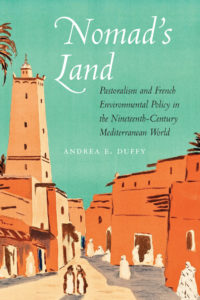 In the 1800s, shepherds around the Mediterranean Sea moved their flocks between summer and winter pastures seasonally, traveling through forests in southern France and other areas.
In the 1800s, shepherds around the Mediterranean Sea moved their flocks between summer and winter pastures seasonally, traveling through forests in southern France and other areas.
But by the end of the 19th century, the number of nomadic shepherds had dwindled sharply. Andrea Duffy, director of Colorado State University’s International Studies Program, wanted to know why, and she’s just published a book, Nomad’s Land, that explores the various reasons for the decline in what she calls “Mediterranean mobile pastoralism.”
Duffy, a special assistant professor in the College of Liberal Arts, examines three geographic areas in her book: the region of Provence in southern France, French colonial Algeria and Ottoman Anatolia, or modern-day Turkey.
The book, an expansion of her 2013 doctoral dissertation, was published this fall by the University of Nebraska Press. In it, Duffy writes that one of the major reasons for the decline in mobile pastoralism was a growing feeling that shepherds, sheep and goats were bad for forests. Foresters were concerned because they thought the animals damaged trees by feeding on saplings while shepherds increased the incidence of fire. The emergence of French environmental policy, especially “scientific forestry,” led to efforts to end the seasonal movements of shepherds and their flocks, Duffy argues.
Not just the environment

But it was not all about the environment — there were also political and economic drivers. Duffy notes that, with the rise of industrialism, settled agriculture, the centralization of government control, and the growing concentration of populations in cities, nomads began to be seen by many as a thing of the past and not part of the vision for a modern state
In some areas, environmental reasons were used to hide political motivations for removing unwanted people. For instance, in Algeria, French scientific forestry was used to justify the removal of indigenous peoples from their traditional lands, Duffy says. Ironically, when demand for wine rose at around the same time, forests of cork trees in Algeria were cut down to make bottle stoppers. And since the French vilified the type of sheep raised by indigenous Algerians, they brought in their own sheep from France.
“There were multiple levels of factors going on at the time,” Duffy says. “And it’s hard to access the perspectives of these nomadic people, because they didn’t write things down.”
So for her book, Duffy relied primarily on other sources, including what government officials were saying about the nomads and what laws were passed to deal with perceived problems. She had to brush up on her Arabic, French and Turkish to do the research, and even turned to climate data: The end of the Little Ice Age in the second half of the century led to extreme weather changes like floods and droughts. Those changes often led to high death rates in flocks, as well as famine, which prompted shepherds to kill many of their sheep for food. Nomads also lost primary food sources when farm products declined.
Voice for the voiceless
Duffy, who teaches Middle Eastern history and specializes in the environmental history of the Mediterranean region, looks at her book as an opportunity to give voice to a group of people who have largely been voiceless. She was inspired to write about the topic after reading The Destruction of the Bison by Andrew Isenberg, which chronicles efforts by the United States to encourage the wanton killing of buffalo, to eradicate this source of subsistence for Native Americans.
“That was such a tragic image for me,” Duffy says. “This is like a parallel history. I’m proud of how it connects multiple regions and multiple cultures. And it’s a reminder that good intentions don’t always lead to positive impacts. Those who forget history make the same mistakes again.”
Duffy used a resident fellowship from the School of Global Environmental Sustainability in 2016-17 to complete the book. More information about Nomad’s Land is available at https://col.st/g66jb. It is for sale at the CSU Bookstore.